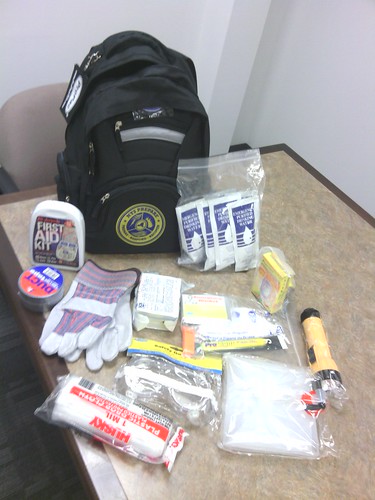With winter upon us, the United Way shares tips on how to plan ahead
Members of The Stand’s Board of Directors recently attended information sessions to help them understand what they can do to be prepared in the event of an emergency, specifically a natural disaster. Natural disasters often result in the disruption of everyday life and include inaccessibility to safe environments, transportation, health care, fresh food, clean water and family members for a certain amount of time.
To help area residents, United Way of Central New York was able to offer disaster preparedness education to communities throughout the region after receiving a 10-month grant. Attendees were able to walk away with one of 300 emergency starter kits for each family represented, put together and donated by Keller Williams Realty and volunteers.
 Shavel Edwards, volunteer coordinator with the Community Impact Division from United Way, led the charge in visiting counties to provide information and resources to the community about preparedness.
Shavel Edwards, volunteer coordinator with the Community Impact Division from United Way, led the charge in visiting counties to provide information and resources to the community about preparedness.
Edwards shared insight that is beneficial to individuals who were not able to attend any of the sessions.
TS: Why does United Way of CNY think it is important to offer emergency preparedness education to the communities throughout the region?
Edwards: “It is important because New York state ranks No. 4 on the list of natural disasters within the last 50 years throughout the nation. People think that we are only affected by snowstorms and maybe the occasional flooding, but we’re actually affected by snowstorms, ice storms, flooding, hurricanes and tornadoes as a state. It’s important for us to [help prepare our communities] and make them aware of the disasters that may affect our area.”
TS: With events like the flooding in Oneida last year, how likely is it that natural disasters like that will occur in Syracuse? It seems like we’re in an area where similar events aren’t that frequent.
Edwards: “A disaster is not planned. It’s unexpected. The best thing we can do is plan for the unexpected and prepare. Now that we know that we’re No. 4, the best thing we can do is prepare. Just like we prepare for snowstorms since we’re No. 1 in the nation in response to snow, when we get a foot of snow, we can still function. Other cities may get an inch of snow and it shuts down the whole city, so we can use [those] same tactics.”
TS: What would you say are the most important things for families to do to prepare for a natural disaster?
Edwards: “One thing to do is to have a kit ready. [The kit should contain] supplies just in case [families] have to leave their home in an emergency. A kit includes some personal items, depending on the time of the year. Items can be a blanket, cash on hand (if there is a disaster, people may not be able to get to an ATM). They should have items ready for children, especially for infants like diapers and formula. Extra medication [should be on hand], and also nonperishable food and water should be in the kit. [Those] are the most important things.
“The second thing is to have a plan of action. Families may not be together at the time of a disaster. [Families] need to have a plan for where [they] are going to meet, and who [they] are going to call and contact to notify that everyone is OK. Also, [include how you will look] out for pets and animals as far as a plan of action. Who is going to pick up your child if you cannot make it? If they are stuck at school and you cannot get to your child, who is a person that they can contact?
“More specifically at home, if something happens in your home, where is your meeting place going to be? If something happens, so no one is running back into the home to try to save someone that may be outside, it’s good to have a safe meeting place outside the home where everyone can go.
“Lastly, be informed. There are a number of different websites that you can look at. There’s FEMA’s ready.gov website, and also locally, prepare.ny.gov, the statewide governor’s site. [Both] have information on how you can be prepared.”
TS: What advice can you offer Syracusans when it comes to preparing for emergencies?
Edwards: “On the ready.gov FEMA site, they can mail you free information. You can go to the library and get free information, and you can also go on their website and get information for kids. It doesn’t cost that much to be informed. It just takes time to educate yourself.”
— Article by Tajuana Cerutti, The Stand board member
 The Stand
The Stand

